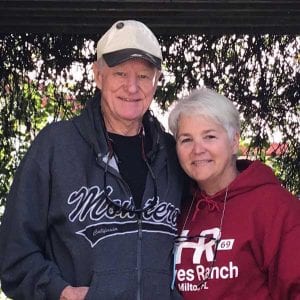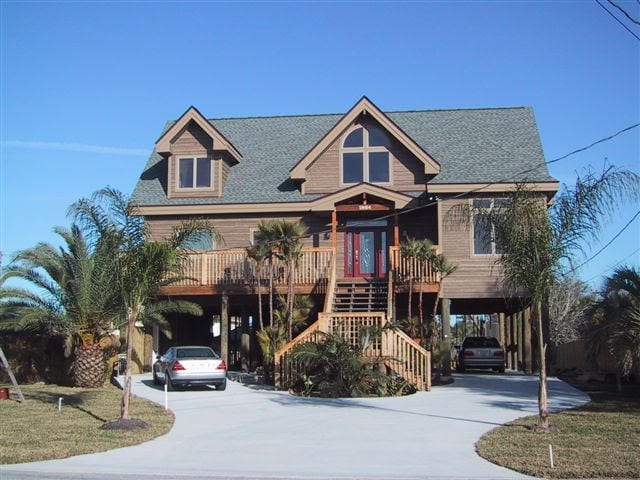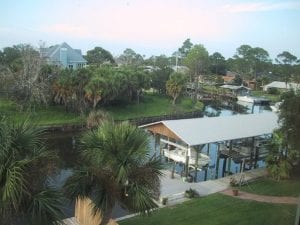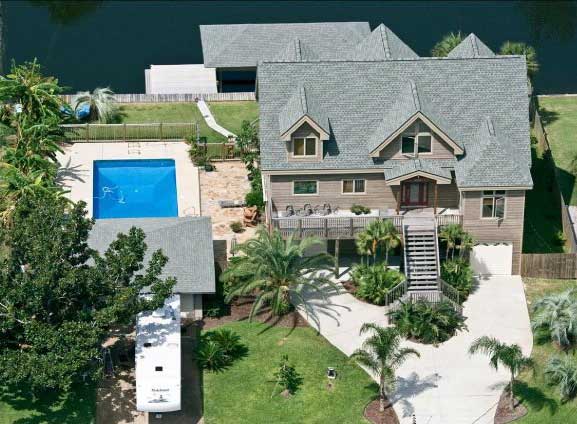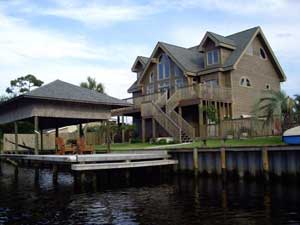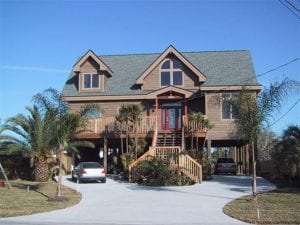Stories Rebuild Tips From a Hurricane Survivor
When Gina Covell Maddox lost her home in Hurricane Ivan (2004), she turned to independent Lindal Cedar Homes distributors Manson and Laura Peppers of Blue Ridge Cedar Homes to design and build her new home. During the rebuilding process, Gina and her husband (pictured below) lived in an RV on their property – as did many of their neighbors who were in a similar situation.
Building a Hurricane-Resistant Home
Manson Peppers said the build process took a couple of years from start to finish, primarily because of permitting and insurance issues, not to mention labor shortages due to the sheer number of people rebuilding at the same time.
“The wind factor is 150 miles per hour on the house,” Peppers said. “There is impact-resistant glass in the windows and a special attachment system to tie them into the frame. The home was built on 12-foot posts with wooden poles pile-driven into the ground. We tied the beams onto those and later framed the lower part in with an enclosed room and breakaway walls. All AC units and water heaters had to be up above the flood level. You can’t have any finished rooms below flood level, and nothing you put down there is insurable.”
The Rebuild Process
As the victims of this year’s devastating hurricane start the long process of rebuilding their homes, Gina has some tips to share, along with words of advice and comfort. The following was originally published by Gina as a Facebook post and reprinted here with her permission.
Lindal Cedar Homes is currently offering a 10% discount on home packages to hurricane, fire, and flood victims who wish to rebuild their homes. Read the press release here and contact your local Lindal distributor for more information.
The Maddoxes built a new Lindal Cedar Home on the same site where their old home (not a Lindal) was destroyed by Hurricane Ivan.
Insurance Issues
If your home (or that of a friend or family member) was destroyed or damaged so much by [a hurricane] that you cannot live in it, AND you have homeowners insurance with a temporary living expenses benefit, keep reading.
I lost everything to Hurricane Ivan in 2004 and learned a few things through the recovery and rebuilding process. When we returned after the storm our house was still sort of standing but not repairable. Friends gave us a couch for a few nights but we quickly realized we were homeless. Even though we were blessed enough to afford to pay some rent there were no apartments or hotel rooms within a three-hour drive of our home. We went to our insurance company who told us they would put us on a list for a FEMA trailer, but we were told it would be up to two months because we went to the bottom of the priority list. (Two adults with insurance, income, no children.) They helped those in the most need first. Then, the insurance company told us to buy an RV to live in because we had the means to do so. We had a $20,000 cap on our temporary living expenses clause, so as soon as possible we purchased a 29 ft RV for a little bit over the $20,000, believing we would be reimbursed the $20K. We had the RV delivered to the driveway of our destroyed home. We were lucky enough to get water and power to our property within 10 days of the storm. (God bless the crews that come into our communities.)
RV Living Onsite
After a few weeks and well into the horrific insurance adjustment process, we were told that the temporary living expenses money only paid for RENT, and that if they reimbursed us for the purchase of the RV they would own it and take it back after we found a permanent residence to move in to. Luckily, a very kind insurance adjuster suggested we “sell” our RV to a family member and pay them “rent.” All he needed to reimburse us for monthly rent was a signed rental agreement. So, I have an amazing Mom who “bought” my trailer from me and rented it back to me at a VERY HIGH rental amount. We paid our monthly rent and quickly depleted the $20K temporary living expenses. Guess what? Mom didn’t evict us when the rent reimbursement ended. That RV was our home for two years and three months while we built a new home.
Things that might help during the rebuild process:
Try to be nice to your insurance adjuster in the beginning. Some are very nice and will do everything they can to help you. Some are a**es, but try being nice first.
Be creative. Find legal ways around silly rules.
If you buy an RV, buy the largest and nicest you can afford. I didn’t realize how long I would live in that thing and I’m glad we upgraded a bit. There were several families with kids that lived in RVs just like us. If I were in your situation today I would head to Dixie Horse and Mule Company for a living quarters trailer because that horse area would be a versatile bonus area. I’ve bought two trailers from Keaton Daw at DHMCO over the years. Good peeps.
Even when homes became available to rent, we opted to stay in our rent-free RV “gifted” to us from Mom. The money we would have paid in rent went into rebuilding our home. Also, we “added on” using a plastic storage shed and bootlegged a washer and dryer. We were the envy of the neighborhood – all of us living in trailers and RVs.
The RV in which the Maddox’s resided while their new home was constructed is visible the lower left-hand side of this photograph.
Living on site while building our new home gave us an advantage to getting the home rebuilt to our standards and keeping an eye on things. My husband served as our general contractor while we built a new custom designed Lindal home using a building materials package. Contact your local Lindal representative, and tell them you are a hurricane victim. Lindal is currently offering 10% discount on their home packages to victims of the recent hurricanes and floods. I love my Lindal home.
Do whatever you can in the rebuilding process. We painted our own interior and did lots of other things to stretch our budget.
Don’t Give Up
Don’t give up. There is light at the end of the tunnel. Search for good information and make informed decisions. Spend your insurance money wisely and you can have a nice new home. It will be really, really hard and progress will be slow if you decide rebuilding is right for you, but the reward is amazing. I still love my new home to this day.
You will realize you are tougher than you think. You will come through this disaster a stronger person. Rely on your faith, family, friends, and, most importantly, your ability to be brave and work hard.
Members of the community where the Maddox’s lived in Pensacola, Florida, pulled together after the Hurricane to help one another during the rebuilding process.
My neighborhood pulled together, shared resources and information, and we became very close through the rebuilding process. Get to know your neighbors. Hold each other up. And know that people all across the country are donating, volunteering and praying for you.
-Gina Covell Maddox
